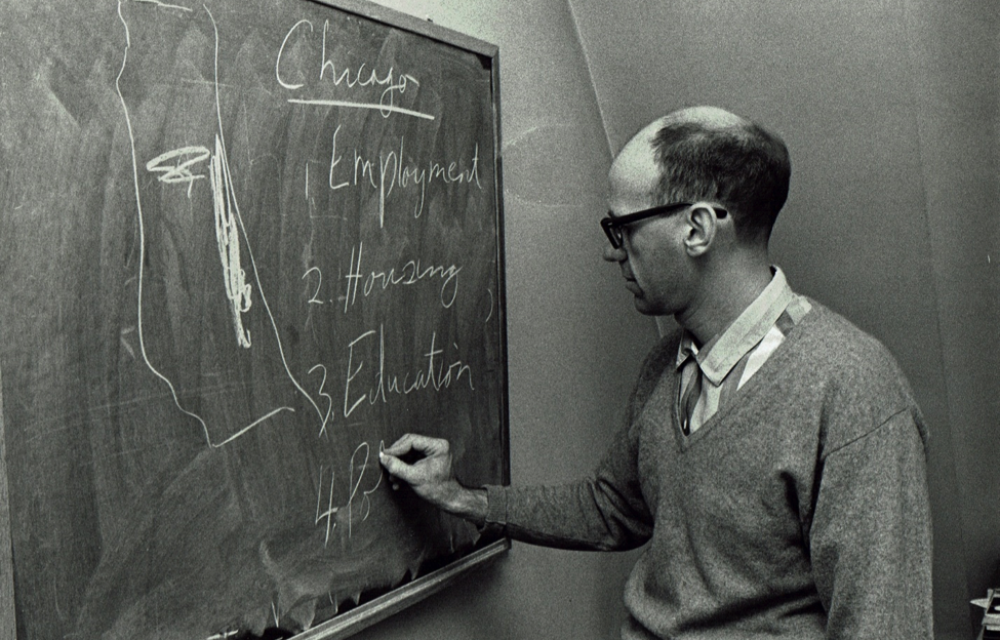Synopsis by Chelsea Birchmier
Baron introduces this essay with a cartoon from a newspaper editorial in which one Black character says to the other, “Sure I’d be glad to integrate that lunch counter, if I had a dime for a cup of coffee.” This cartoon provides a segue into one of the central claims of the chapter: “Negro revolt” in the North in the 1960s would have to go beyond the Civil Rights strategy of the South to transform the conditions of Black unemployment. In the North, de jure equality—equality before the law—did not preclude de facto inequality in the form of ghetto-based school and housing discrimination and dual job markets. In this paper, Baron examines the economic conditions of the North with a particular focus on Chicago in order to understand the future of Black struggle.
He begins with a national economic analysis, comparing Black and white employment conditions from 1947 to 1962. Compared to the relative stability of 1947 to 1957, job growth, particularly in the private sector, stagnated after 1957. In particular, Black unemployment grew, with a racial gap in employment that almost tripled from 1948 to 1962 despite a decreasing educational gap. Black workers made up 20% of the unemployed, 26% of the long-term unemployed (15 weeks to 6 months), and 27% of the very long-term unemployed (6 or more months). Rising unemployment was related to the technological displacement of labor through automation and decreasing growth in the Gross National Product (GNP), the majority of which was been due to increasing productivity rather than an expanding labor force. Additionally, more than half of the rise in employment during this time period was due to part-time jobs, and 2/3 was due to women joining the labor force. These trends forewarned of “disaster” for the labor market in the coming decade, with 26 million youth entering the job market and a sluggish rate of job growth.
He then narrows his focus to the local context of Chicago, providing population and labor force statistics for both the city of Chicago and the Chicago metropolitan statistical area. He reveals a large racial gap in unemployment for both the city and the metropolitan area in 1960, with Black unemployment around 11% and white unemployment less than 4%. He then points out that a government or labor market concept of unemployment only includes active job seekers, excluding “discouraged workers,” who have abandoned the job search due to the near impossibility of getting a job. Using a “social concept of unemployment” that includes discouraged workers, he arrives at a Black male unemployment rate of 16% for the city of Chicago and 17% for the metropolitan area. Next, he discusses the issue of marginal employment, including workers who are part-time (for economic reasons rather than by choice) or earning below a living wage. In the Chicago metropolitan area, 31% of Black men were marginally employed compared to 12% of white men; 60% of the unemployed also fell into this category. He shows how Black unemployment was concentrated in low-income housing areas—public housing projects in particular—meaning that the Black unemployed generally could not rely on their neighboring community for financial support. Unemployment was accompanied by increasing dependence on welfare assistance such as Aid to Dependent Children (ADC). Like the national unemployment situation, he suggests that disaster was immanent in Chicago without extensive social and economic change.
Finally, Baron returns to the question of Negro revolt. He argues that the civil rights strategy of equal employment opportunity could not address the problems of the shrinking labor market in the 1960s economic downturn, nor could it address widespread Black unemployment in times of overall prosperity; to this latter point, he cites economists Joan Robinson and John Dunlop who describe the geographic and social isolation unemployment and “the balkanization of the unemployed,” respectively. While high rates of unemployment impacted other groups, including Hispanic people and coal mining regions, Baron suggests that the momentum and groundwork established by the Civil Rights Movement positioned Black unemployed people as the primary actors able to bring the economic question to national attention and to draw out other unemployed groups “from behind the color curtain.” He writes that unemployed Black workers were learning from the lessons of Black struggle in the South and adapting mass Civil Rights tactics to the Northern context. “Tomorrow,” he writes, “the chances are that, taking a clue from the civil rights movement, the unemployed will speak for themselves.”

